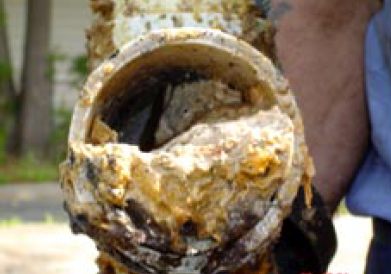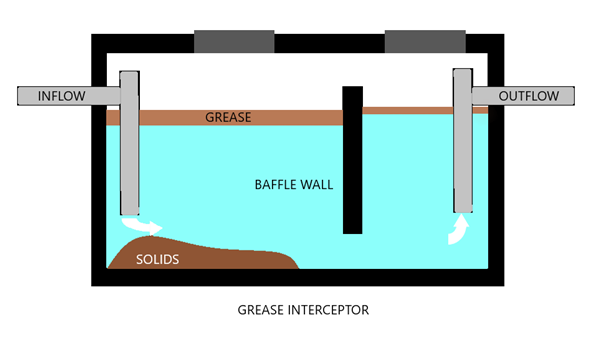Grease Interceptor Program
Introduction
 Fats, Oils, and Greases (FOG) include animal and vegetable fats as well as other oils that are used to cook and prepare food. Food Service Establishments (FSE) generate large volumes of FOG during the course of their operations. Excess FOG discharged in wastewater can build up in pipes causing major damage and often leads to sewage back-ups and overflows. Untreated sewage from these overflows can contaminate local water sources, cause property damage, and impact public health.
Fats, Oils, and Greases (FOG) include animal and vegetable fats as well as other oils that are used to cook and prepare food. Food Service Establishments (FSE) generate large volumes of FOG during the course of their operations. Excess FOG discharged in wastewater can build up in pipes causing major damage and often leads to sewage back-ups and overflows. Untreated sewage from these overflows can contaminate local water sources, cause property damage, and impact public health.
To prevent this from occurring, regulations have been established that require FOG to be properly managed and prevent its discharge into sanitary sewer systems. As part of these regulations, Lexington-Fayette Urban County Government (LFUCG) ordinances require all facilities that provide food service and/or preparation to install grease interceptors to minimize the FOG that enters the sanitary sewer. Grease interceptors are devices installed on the sanitary sewer collection system for the purpose of trapping or intercepting FOG from the wastewater discharge. This FOG is then removed from the Grease interceptor and either taken to a landfill for disposal or recycled.
Grease Interceptor Function
 Whether installed under the sink or in-ground, grease interceptors all function in the same manner and have done so since the late 19th century. These plumbing devices work by trapping FOG and preventing them from flowing into the sewage system. Grease interceptors consist of a tank filled with water, entry and exit tees, a baffle, and access points for maintenance. As wastewater flows from a sink drain, it enters the tank through the inflow tee. This slows the velocity of the wastewater and allows it to enter the tank below the surface. The reduced velocity and cooling effect from the tank allow the FOG to harden and the food solids to settle to the bottom. The FOG fills the grease trap from the top-down displacing water, allowing clear water to pass beneath the baffle wall where it enters the outflow tee and discharges to the sanitary sewer. The accumulating FOG and food solids must be periodically removed from the tank in order to maintain proper operation and prevent a release of FOG to the sanitary sewer system.
Whether installed under the sink or in-ground, grease interceptors all function in the same manner and have done so since the late 19th century. These plumbing devices work by trapping FOG and preventing them from flowing into the sewage system. Grease interceptors consist of a tank filled with water, entry and exit tees, a baffle, and access points for maintenance. As wastewater flows from a sink drain, it enters the tank through the inflow tee. This slows the velocity of the wastewater and allows it to enter the tank below the surface. The reduced velocity and cooling effect from the tank allow the FOG to harden and the food solids to settle to the bottom. The FOG fills the grease trap from the top-down displacing water, allowing clear water to pass beneath the baffle wall where it enters the outflow tee and discharges to the sanitary sewer. The accumulating FOG and food solids must be periodically removed from the tank in order to maintain proper operation and prevent a release of FOG to the sanitary sewer system.
Regulatory Requirements
The Clean Water Act requires the control of pollutants which pass through or interfere with Publicly Owned Treatment Works (POTW) processes. To implement these requirements, National Pretreatment Program regulations (40 CFR 403) were developed that prohibit “solid or viscous pollutants in amounts which will cause obstruction” in treatment plants and their collection systems. The primary responsibility for enforcing national pretreatment standards rests with states and approved local authorities. As the owner and operation of two Wastewater Treatment Plants and over 1400 miles of sewer pipe, the LFUCG is one of these authorities. As such, they have developed several ordinances specifically relating to FOG:
|
LFUCG Code of Ordinances – Chapter 16. Article V: |
|
|
Section 16-43 |
Forbids any water or waste containing non-emulsified fats, wax, grease, or oils in excess of 100 mg/L or containing substances which may solidify or become viscous at temperatures between 32 degrees and 150 degrees Fahrenheit from being discharged into public sewer. |
|
Section 16-44 (a) |
Requires all facilities that provide food service and/or preparation activities to install grease and oil interceptors. |
|
Section 16-44 (c) |
Requires all facilities that must install a grease interceptor to apply for a grease interceptor permit from the LFUCG Division of Water Quality |
|
Section 16-44 (d & e) |
Stipulates requirements for the design and installation of grease interceptors, includes standard drawing. |
|
Section 16-44 (g) |
Requires grease interceptors to be cleaned on a regular basis (in accordance with the facility’s permit) |
|
Section 16-44 (h) |
Requires operation and maintenance records for grease interceptors to be maintained for a minimum of three years and specifies the information to be documented in these records |
|
Section 16-44.1 |
Allows for the request of a Special Grease and Oil Interceptor Permit for those facilities that are unable to install a grease interceptor that meets approved sizing requirements or that may not require a grease interceptor based on their operations. |
To enforce these regulations, the LFUCG has an extensive FOG program that oversees the permitting and inspection of all FSEs within the LFUCG service area.
The University Grease Interceptor Program
There are over 45 facilities at the University that provide food service and/or food preparation activities to the population. To support these facilities and maintain compliance with the University’s Industrial User Permit and LFUCG ordinances, approximately 50 grease interceptors have been installed. Environmental management is responsible for assessing compliance with the applicable regulations and acting as a liaison between the University and LFUCG inspectors while Dining Services, Facilities Management, and Athletics are responsible for the proper operation, maintenance, and recordkeeping for each unit. Any new FSE added to a campus facility is required to install a grease interceptor and to submit the proper application materials to LFUCG for review and approval.
Permit Requirements
Each of the grease interceptors installed on campus is covered by an LFUCG Grease Interceptor Permit. These permits contain the following conditions/requirements that must be met:
- The grease interceptor must be sized according to that specified in the permit.
- Cleanings must occur when the total of the grease layer and solids layer exceed 30% of the wet volume of the interceptor, but no less often than the frequency required in the permit.
- Best Management Practices must be implemented to minimize the discharge of FOG to the sewer system. BMPs to be implemented include:
- Segregation and collection of waste cooking oils
- Scraping food scraps into garbage prior to washing
- Wiping FOG from pots, pans, and other cookware prior to washing
- Pre-rinse all dishes prior to loading into dishwasher
- Kitchen Signage indicating BMPs and waste minimization practices shall be posted conspicuously in the food prep and dishwashing areas at all times.
- Employees involved in cooking and cleaning activities shall be trained on the following:
- How to dry wipe pots, pans, cookware, and work areas to remove grease prior to washing.
- How to properly dispose of food waste and solids in enclosed plastic bags prior to disposal in trash bins or dumpsters to prevent leaking and odors.
- Proper methods for disposal of grease and oil from cooking equipment into a grease recycling receptacle without spilling.
- The location and use of absorption products to clean under fryer baskets and other locations where grease may be spilled or dripped.
- Additives for the purpose of emulsifying of biologically/chemically treating FOG for grease remediation may not be introduced into the wastewater system without obtaining written authorization from LFUCG.
- All waste cooking oil shall be collected and stored properly in receptacles for recycling/proper disposal.
- Wastewater with temperatures in excess of 140 degrees Fahrenheit is prohibited from being discharged into any grease control device.
- Waste from the cleaning of grease interceptors must be properly disposed of and may only be transported off site by a certified waste hauler.
- A maintenance log must be kept of interceptor maintenance and cleaning activities. The log must include:
- Date
- Person/company performing the cleaning
- Estimation of grease removed
- Records (maintenance logs and any other documentation of cleanings) must be maintained onsite for a minimum of three years.
- Records shall be made available to LFUCG inspectors.
Inspections
LFUCG regularly performs inspections to ensure compliance with grease interceptor requirements. There are two types of inspections:
Construction Inspections: All grease interceptors must be inspected after installation. Inspections are performed before the unit is covered to ensure that all connections have been properly sealed and that the grease interceptor conforms to LFUCG standards. This is in addition to the inspection conducted by the Kentucky Department of Housing, Buildings, and Construction Division of Plumbing. LFUCG must receive notification from the contractor/project manager when the unit will be installed/is ready to be inspected.
Compliance Inspections: Grease Interceptor inspections are conducted annually based on a performance-based ranking system:
|
Category |
Characteristics |
Inspection Frequency |
|
Low Risk (includes exempt/waivers) |
Low volume, no history of grease problems in area, adequate grease control |
20% per year or more frequently as needed (100% of FSEs are inspected every five years). |
|
Medium Risk |
Adequate grease control with risk of producing grease, frequent maintenance required, grease control equipment undersized but properly maintained, some history of grease problems in area |
Annually or more frequently as needed |
|
High Risk |
High volume, inadequate grease control equipment, insufficient maintenance of grease control equipment, discharges of grease are impacting sewer system/history of grease problems in area |
Semiannually or more frequently as needed |
Inspections involve a review of maintenance/clean-out records, the inspection of downstream manholes for grease buildup, and inspection of the grease interceptor to determine the level of grease and verify that the trap is functional. Best Management Practices will be observed if possible/as needed. These inspections are scheduled through Environmental Management and responsible campus entities will be contacted and asked to provide records prior to the inspection being performed.
Documents
LFUCG External Grease Interceptor Standard Drawing
LFUCG Cleaning and Maintenance Log
Example Grease Interceptor Permit
Training Materials
Educational Materials & Signage
LFUCG Always & Never BMP Signage
